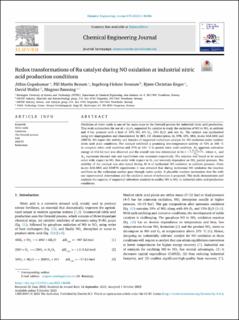| dc.contributor.author | Gopakumar, Jithin | |
| dc.contributor.author | Martin Benum, Pål | |
| dc.contributor.author | Svenum, Ingeborg-Helene | |
| dc.contributor.author | Enger, Bjørn Christian | |
| dc.contributor.author | Waller, David | |
| dc.contributor.author | Rønning, Magnus | |
| dc.date.accessioned | 2024-02-21T15:09:14Z | |
| dc.date.available | 2024-02-21T15:09:14Z | |
| dc.date.created | 2023-10-11T13:20:42Z | |
| dc.date.issued | 2023 | |
| dc.identifier.citation | Chemical Engineering Journal. 2023, 475: 146406. | en_US |
| dc.identifier.issn | 1385-8947 | |
| dc.identifier.uri | https://hdl.handle.net/11250/3119108 | |
| dc.description.abstract | Oxidation of nitric oxide is one of the main steps in the Ostwald process for industrial nitric acid production. This work summarises the use of - supported Ru catalyst to study the oxidation of NO to NO at ambient and 4 bar pressure with a feed of 10% NO, 6% O , 15% O, and rest Ar. The catalyst was synthesised using wet impregnation and characterised by BET, CO chemisorption, -TPR, XPS, XRD, in-situ XAS-XRD and DRIFTS. We report the activity and kinetics of supported ruthenium catalyst for NO oxidation under realistic nitric acid plant conditions. The catalyst exhibited a promising low-temperature activity of 72% at 340 °C in complete nitric acid condition and 37% at 420 °C in partial nitric acid condition. An apparent activation energy of 152 kJ/mol was observed and the overall rate was determined to be r = , where and represents forward rate and equilibrium rate constants respectively. The reaction was found to be second order with respect to NO, first order with respect to O and inversely dependent on NO partial pressure. The stability of the catalyst was also tested during 45 h of isothermal NO oxidation at ambient pressure. From in-situ XAS-XRD and DRIFTS experiments it was revealed that during isothermal NO oxidation the reaction oscillates as the ruthenium surface goes through redox cycles. A plausible reaction mechanism that fits with our experimental observations and the oxidative nature of ruthenium is proposed. This study demonstrates and explains the capacity of supported ruthenium catalysts to oxidise NO to NO in industrial nitric acid production conditions. | en_US |
| dc.language.iso | eng | en_US |
| dc.rights | Navngivelse 4.0 Internasjonal | * |
| dc.rights.uri | http://creativecommons.org/licenses/by/4.0/deed.no | * |
| dc.title | Redox transformations of Ru catalyst during NO oxidation at industrial nitric acid production conditions | en_US |
| dc.title.alternative | Redox transformations of Ru catalyst during NO oxidation at industrial nitric acid production conditions | en_US |
| dc.type | Peer reviewed | en_US |
| dc.type | Journal article | en_US |
| dc.description.version | publishedVersion | en_US |
| dc.rights.holder | © 2023 The Author(s). Published by Elsevier. | en_US |
| dc.source.pagenumber | 14 | en_US |
| dc.source.volume | 475 | en_US |
| dc.source.journal | Chemical Engineering Journal | en_US |
| dc.identifier.doi | 10.1016/j.cej.2023.146406 | |
| dc.identifier.cristin | 2183739 | |
| dc.relation.project | Norges forskningsråd: 237922 | en_US |
| dc.relation.project | Norges forskningsråd: 296087 | en_US |
| dc.relation.project | Swiss National Science Foundation: 206021_189629 | en_US |
| dc.relation.project | Norges forskningsråd: 295864 | en_US |
| dc.source.articlenumber | 146406 | en_US |
| cristin.ispublished | true | |
| cristin.fulltext | original | |
| cristin.qualitycode | 2 | |

